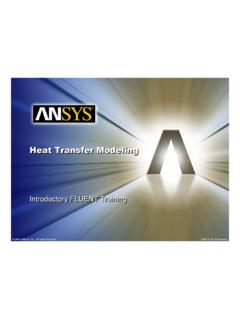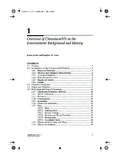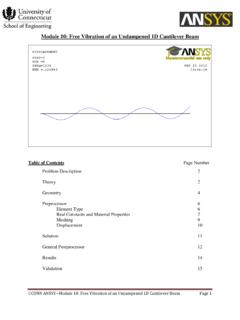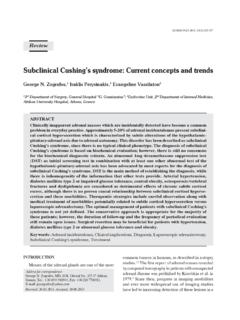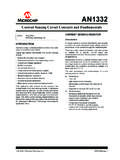Transcription of Basic Concepts in Electrochemistry
1 1 Basic Concepts in Electrochemistry2 Electrochemical CellElectronsCurrent+-ANODECATHODEC urrentVoltage Source3 Fuel CellElectrons (2 e)Current-+ANODECATHODEC urrentElectrical LoadH22H++ 2e O2+ 2H++ 2e H2O4 Electrolysis CellElectrons (2 e)Current+-ANODECATHODEC urrentVoltage Source2 H+; SO4 2-H2O O2+ 2H++ 2e2H++ 2e H25 What is Electrochemistry ? Electrochemistry is defined as the branch of chemistry that examines the phenomena resulting from combined chemical and electrical of processes This field covers:-Electrolytic processes: Reactions in which chemical changes occur on the passage of an electrical current -Galvanic or Voltaic processes: Chemical reactions that result in the production of electrical energy 7 Electrochemical cellAn electrochemical cell typically consists of.
2 -Two electronic conductors (also called electrodes) -An ionic conductor (called an electrolyte)8 Modes of charge transportCharge transport in the electrodes occurs via the motion of electrons (or holes), Charge transport in the electrolyte occurs via the motion of ions (positive and negative)9 Reactions half cell and overallAt each electrode, an electrochemical reaction occurs. This reaction is called a half cell reaction (since there are two electrodes in a typical cell at which reactions occur)The overall chemical reaction of the cell is given by combining the two individual half cell reactions10 Half cell reaction types There are two fundamental types of half cell reactions:-Oxidation reactions -Reduction reactionsA reaction is classified as oxidation or reduction depending on the direction of electron transfer11 Oxidation and reduction energetics12 Oxidation Involves the loss of an electron Involves the transfer of electrons from the species to the electrodeR = O + ne(1)Oxidation is an energetic process, and occurs when the energy of the electrode dips below the highest occupied molecular orbital of the compound see figure part b13 Reduction Involves the gain of an electron Involves the transfer of electrons from the electrode to the speciesO + ne= R (2)
3 Reduction is also an energetic process, and occurs when the energy of the electrode increases above the lowest vacant molecular orbital of the compound see figure part a14 Example of electrochemical cellZinc and copper metals placed in a solution of their respective sulfates, and separated by a semi permeable membrane15 Reactions Zinc metal gets oxidized -goes into solution:Zn = Zn 2++ 2e (3) Copper ions in solution reduced; copper metal -deposited on the copper electrode Cu2++ 2e = Cu (4) Electrons for reduction obtained from the zinc electrode -external wire Sulfate ions [reaction (4)] migrate through the membrane, -react with the zinc ions [from (3)] -zinc sulfate 16 Convention Electrode at which the oxidation reaction occurs is called the anode Electrode at which the reduction reaction occurs is called thecathodeThus in the above example, the zinc electrode was the anode and the copper electrode was the cathode17 Working and counter electrodesThe electrode at which the reaction of interest occurs is calledthe working electrodeThe electrode at which the other (coupled)
4 Reaction occurs is calledthe counter electrodeA third electrode, called the reference electrode may also be used 18 What gets oxidized? In previous example:-Zn was oxidized-Cu was reducedFor a given set of two reversible redox reactions, Thermodynamicspredicts which reaction proceeds as an oxidation and which proceeds as a reduction19 Electrode potentialThe electrode potential for a reaction is derived directly from the free energy change for that reaction G = -NFE The standard oxidation potential is equal in magnitude, but opposite in sign to the std. reduction potential20 Competing reactions For a set of 2 competing reactions:The reaction with the lower standard reduction potential gets oxidized -the other reaction proceeds as a reductionZn = Zn 2++ 2e (3) E red= VCu2++ 2e = Cu (4) E red= VThus, in the above example, Zn is oxidized, and Cu is reduced21 Rationale Gcell= -NFEcellEcell= Ecathode E anodeFor a feasible reaction: Ecellmust be positive (so that Gcellis negative recall thermodynamic criterion for feasibility)Therefore.
5 Ecathode E anode > 0 or Ecathode> E anode22 Since oxidation occurs at the anode the species with the lower reduction potential will get oxidized This is to ensure that Gcellis negative This is why Zn got oxidized (and Cu reduced) in the above example. In this case: Ecell= If the reverse were to occur, Ecellwould be: , leading to a positive Gcell23 Sources of E red valuesComprehensive listings of E redvalues for most half cell reactions are available in:-The Lange s Handbook of chemistry-The CRC Handbook of chemistry and physics24 Faraday s lawRelationship between the quantity of current (charge) passed through a system, and the quantity of (electro) chemical change that occurs due to the passage of the current25 Mathematical statementm = M I t /n F (5)m -mass of substanceM -molecular weight of the substanceI -current passed (A)t -time for which the current is passed (s)n -number of electrons transferredF -Faraday constant (96475 C / eqv)
6 26 Key conceptThe amount of chemical change is proportional to the amount of current passed27 Faraday s second lawRestatement of the first law for a fixed quantity of charge passing through the system28 Faradaic processesAll processes that obey Faraday s law are termed faradaic processesAll these processes involve electron transfer at an electrode / electrolyte interfaceThese reactions are also called electron / charge transfer reactionsElectrodes at which these processes occur are called charge transfer electrodes29 Nonfaradaic processesSometimes changes exist in the electrode / electrolyte interface without charge transfer taking placeThese changes are due to processes such as adsorption and desorptionSuch processes are called nonfaradaicprocesses30No electrons flow through the electrode / electrolyte interface during nonfaradaic processesHowever, transient external currents can be generated by nonfaradaic processes31 More on nonfaradaic processesFaradaic processes interest us the most!
7 Therefore, care must be taken to ensure that the effects of the nonfaradaic processes are understood and examples of nonfaradaic processes are discussed in the following slides32 Ideally polarized electrodesAn electrode at which there is no charge transfer across the electrode / electrolyte interfaceover all potential rangesis called an ideally polarized electrode (IPE)33 Examples of IPEsNone exist that can cover the entire potential range in solutionA mercury electrode in contact with deaerated KCl behaves as an IPE over a potential range of ~ 2 VOther electrodes are ideally polarized over much smaller ranges34 Behaviour of an IPER ecall no charge transfer possible at IPE / electrolyte interfaceThe behaviour of such an interface when the potential across the electrode is changed resembles that of a plain capacitorAn IPE follows the standard capacitor equation35 Mathematical treatmentQ = CdE(6) capacitor equationQ -charge stored in coloumbs (C)Cd-capacitance in farads (F) E -potential across the capacitor /IPE (V)
8 When voltage is applied across an IPE, the electrical double layer is charged until eqn. 6 is obeyedDuring charging a charging current flows through the system36 Significance of charging currents Contributes to total current measured Cannot be ignored especially for low faradaic currents may exceed faradaic currents in such casesTo better understand the effect of charging, we need to examine mathematically the responses of an IPE to various electrochemical stimuli37 Model representation of an IPECdRsThe IPE system can be represented as a capacitance (Cd) in series with the electrolyte resistance (Rs) 38 Application of a potential step39 InputA potential step is applied the potential is raised from an initial value to a higher value, and held at the higher valueSee previous fig.
9 , bottom graph40 Result of potential step application The double layer is charged Q = CdE (6)NOTE:The applied voltage must equal the sum of the voltage drops across the resistor (Er) and capacitor (Ec), we have 41E = Er+ Ec(7)Applying Ohm s law,Er= I Rs(8)from (6),Ec= Q/Cd(9)Therefore:E = IRs+ Q/Cd(10)42By definition, current is the rate of flow of chargeTherefore:I = dQ/dt(11)Equation 10 can be rewritten as:I = dQ/dt= -Q/RsCd+ E/Rs43 SolutionInitial condition: that the capacitor is initially uncharged (Q = 0 at t = 0)solution of eqn. 2 is:Q = E Cd[1 e (-t/RsCd)] (13)44 Time dependence of charging currentDifferentiating eqn. 13 time, we get:I = (E/Rs) * e (-t/RsCd) (14)Equation 14 describes the time dependence of the charging current in response to a potential step also see following figure, top graph45 Graphical representation46 Practical significanceProduct of Rsand Cdhas units of time called time constant ( )
10 For typical values of Rsand Cd, the charging current dies down to an insignificant level in a few hundred microsecondsAny faradaic current must be measured after this time period to avoid the influence of the charging current47 Back to faradaic processes48 Investigation of electrochemical behaviourInvolves holding certain variables constant while observing the trends in othersTypical variable shown in diagram49 Variables to be consideredVALoad / Power Supply50 Main aspects of interest From a fuel cell point of view, the main aspects of interest are:-Electrochemical kinetics-Ionic and electronic resistances a. In electrolyte b. In electrodes-Mass transport through the electrodesThese processes are illustrated in the following schematic5152 CurrentCurrent may be written as the rate of change of charge:I = dQ/dt(15)The number of moles (N) participating in an n electron electrochemical reaction is given by N = Q/nF(16)53 Reaction rate The electrochemical reaction rate can be written as:Rate (mol/s) = dN/dtFrom 16,Rate = (1/nF) dQ/dtFrom 15,Rate = I/nF(17)Thus the current is a direct measure of the rate of electrochemical reaction54 Reaction flux Sometimes, it is convenient to express quantities as a flux: Dividing the rate (17) by the active area of the electrode(A, cm2), we get.
